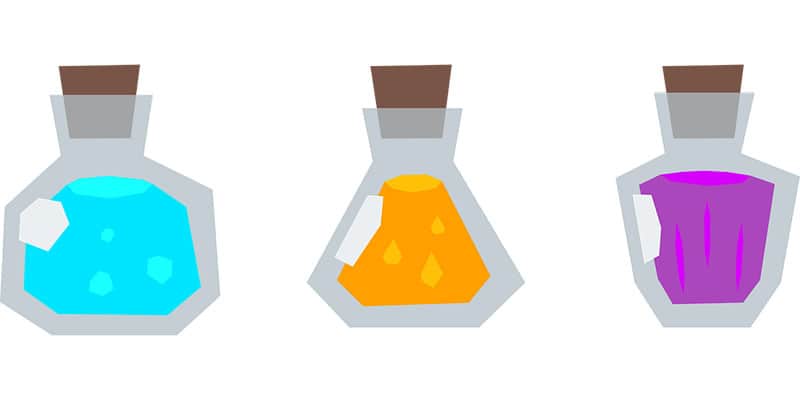To build an artificer alchemist, consider the following:
- Try a gnome or hobgoblin character
- Build artificer as ranged tinkerer
- Choose Item Infusions for invention at first
- Alchemist subclass spells and abilities
- Higher-level base artificer abilities
- Artificer spell choices for alchemist—fire bolt, web, spider climb, cure wounds…
The artificer alchemist class in Dungeons and Dragons 5e is a potion-making tinkerer. This scientist-like character creates spell effects from mundane objects, mixes daily elixirs with wild effects and can even walk around with a mechanical homunculus companion. On top of all these feats of magic and science, I have proficiency with firearms.
Of all the classes, the artificer best fits genre storylines: steampunk, science fantasy, wild west. Using the Dungeon Masters guide, I can match technology with the appropriate time-period. I have a few articles for reference:
If you need a premade pirate campaign to flex your new firearm proficiency, check out my original Dead Man’s Tale. Click here or below to learn more.
Try a rock gnome or hobgoblin character
One could argue this class is handmade for rock gnomes—and one would be correct. However, don’t let a good opportunity for a goblin alchemist go to waste. Either way, playing this character with mischief in mind is the way to go.
Rock gnomes have a +2 Intelligence/+1 Constitution bonus, which fits the class well. Gnome Cunning will give me advantage on Wisdom, Intelligence and Charisma saving throws. Plus, Artificer’s Lore gives me double proficiency for History checks on magic, alchemical and technological items. On top of all this, I can Tinker a small clockwork device just as a rock gnome.
Hobgoblins have a +2 Constitution/+1 Intelligence bonus. Sure, they aren’t quite as smart as the gnomes, but the extra Martial Training and Saving Face abilities come in handy. Martial Training gives me proficiency with 2 martial weapons of my choice. Saving Face grants me additional points to a saving throw or attack roll equal to how many allies I see. I’ll need to rest to recover this ability.
Build artificer as ranged tinkerer
For my basic artificer build, I’ll need to prepare my character for my future alchemist specialization. Therefore, I want to lean into ranged weapons like firearms, shortbows or hand crossbows. This way, I can mix in spellcasting, stay out of too much danger and operate as a support character for my allies.
I gain proficiency with thieves’ tools, tinker’s tools and an artisan tool kit of my choice. I’m thinking brewer’s supplies could be a fun choice to go with my alchemy. Plus, I’ll choose Medicine and Arcana as proficient skills—healing will be a major aspect of my character.
Related Posts:
Guide to Building a Bard College of Creation: DnD 5e
| Guide to Building a Druid Circle of Spores: DnD 5e
|
Magical Tinkering is my first artificer ability, giving me the ability to imbue objects with magical energy and effects. This effect lasts indefinitely. Plus, I’m able to touch an amount of objects equal to my Intelligence modifier. I can choose one of these effects:
- The object glows, shedding light in a 5-foot radius. Dim light appears for 5 more feet.
- A message I implant can be heard when another creature touches the object. This message can be heard up to 10 feet away and lasts 6 seconds.
- A noise or odor radiates from the object and is perceivable up to 10 feet away.
- Create a static picture on the surface of the object—pictures, text and shapes are all fair.
Choose Item Infusions for invention at first
At level 2, I will have the ability to Infuse items with magical benefits. Armor, mechanical companions and weapon enhancements are all on the table. At this level, I know how to make 4 infusions but am only allowed to carry 2. As I level up, I’ll be able to replace Infusions with other choices. Some of the best infusions require high-level ability.
My first Infusion choice is Homunculus Servant. This small automaton can take many different forms and can even fly. The homunculus can completely evade damage on successful Dexterity saving throws and can deal its own damage. However, probably the most useful element is its ability to channel a spell with a range of touch. Therefore, I can send it to heal allies or damage enemies with up-close spell attacks.
Secondly, I’ll choose Replicate Magic Item to create unique magic gear. I can choose from the table in Tasha’s Cauldron of Everything, gaining more powerful items as I level. At 2nd level, I can create items such as an alchemy jug, cap of water breathing and wand of magic detection.
I can switch out these Infusions when I level up, keeping Enhanced Arcane Focus and Repeating Shot as damage options. Enhanced Arcane Focus gives me +1 to spell attack rolls. Repeating Shot gives me a +1 to attack and damage rolls with ranged weapons.
Alchemist subclass spells and abilities
At level 3, I’ll gain proficiency with alchemist’s supplies, learn my first alchemist spells and learn Experimental Elixir.
Experimental Elixir gives me the ability to create 1 magic elixir after a long rest. The effects of this freebie elixir are chosen with a roll of d6 die, and I’ll need an empty vial and alchemist supplies on me. I can create additional elixirs by spending spell slots of 1st level or higher, with the added benefit of choosing the elixir’s effect. This might be one of the coolest aspects of this class. The effects and corresponding die rolls look like this:
- Healing: regain HP equal to 2d4 + my Intelligence modifier.
- Swiftness: walking speed increased by 10 feet for 1 hour.
- Resilience: +1 bonus to AC for 10 minutes.
- Boldness: roll 1d4 and add to attack roll and saving throws for 1 minute.
- Flight: Gain flying speed of 10 feet for 10 minutes.
- Transformation: Transform with alter self Lasts 10 minutes.
Level 5 offers me Alchemical Savant, which adds my Intelligence modifiers to spells using alchemical supplies as a focus. This spell must either be a healing spell or deal acid, fire, necrotic or poison damage.
Restorative Reagents (level 9) amps up my ability to heal, offering me 2 ways of playing doctor.
- Add temporary hit points equal to 2d6 + my Intelligence modifier to a target.
- Cast lesser restoration without expending a spell slot and without preparing the spell. I must use alchemist’s supplies as my spellcasting focus. I can do this a number of times equal to my Intelligence modifier.
Chemical Mastery (level 15) gives me immunity to my own chemical agents.
- I gain resistance to acid and poison damage. I’m immune to poison
- Cast greater restoration and heal the same way as lesser restoration in Restorative Reagents.
Alchemist Spells
Though I’ll often expend spell slots for elixirs, the alchemist subclass offers bonus class spells. This spell list plays on both the chemist and doctor aspect of this class in fun ways.
Level 3
- Healing word: A creature I can see within 10 feet gains 1d4 + Intelligence modifier HP
- Ray of sickness: Fire a sickening magical beam that poisons foes for 2d8 poison damage and poisons them on a failed Constitution save.
Level 5
- Flaming sphere: Create a 5-foot sphere of fire that deals 2d6 fire damage to creatures who start or end their turn within 5 feet of it. The fun part here is that I get to move the sphere around the field.
- Melf’s acid arrow: Splashes acid on foes for 4d4 acid damage on a hit. The target then takes 2d4 acid damage at the end of its next turn.
Level 9
- Gaseous form: Transform a target into a cloud of gas, which has unique effects. Target can’t pick up items and can only move 10 feet of flying speed. However, the target also has advantage on Strength, Dexterity and Constitution saving throws and can slip through tight spaces. Also, they gain resistance to nonmagical damage.
- Mass healing word: Up to 6 targets within range recover 1d4 + Intelligence modifier HP.
Level 13
- Blight: Necromantic energy drains a target of their moisture, dealing a whopping 8d8 necrotic Plant creatures have disadvantage on the Constitution saving throw and the spell deals maximum damage to it.
- Death ward: Grants a target 8 hours of protection from dropping to 0 HP. Instead, target drops to 1 HP and the ward dissipates. If a spell would immediately kill the target, the death ward negates the effect before dissipating.
Level 17
- Cloudkill: Create a toxic, 20-foot radius cloud of poison, dealing 5d8 poison damage to those trapped inside. The cloud drifts 10 feet away from me each turn.
- Raise dead: Bring a creature back to life and cure most conditions it had on death. Curses and magical conditions will stay.
Related Posts:
Guide to Building a Dinosaur Campaign: DnD 5e
| Scariest Sea Monsters in World Mythology
|
Higher-level base artificer abilities
Another benefit of reaching level 3 is The Right Tool for the Job. This ability allows me to build any artisan toolset I could possibly need with 1 hour of uninterrupted work.
Then, level 6 grants me Tool Expertise, which doubles my proficiency bonus for a toolset I’m proficient in. The very next level (7) gives me Flash of Genius, which grants my Intelligence modifier to a saving throw. This ability works for my own saving throws or an ally’s, and I can use it 3 or 4 times depending on my Intelligence modifier.
Level 10 transforms my character into a Magic Item Adept, adding a couple of features for magic item use. First, i can attune up to 4 magic items at once. Secondly, if I craft a magic item with a rarity of common or uncommon, it takes me a quarter of the normal time to make. Also, my cost is cut in half. Again, the very next level (11) grants me Spell-Storing Item, which gives me the ability to store spells in items. The holder of the item can then trigger the spell as an action. Yes, I can store a damage spell in a weapon for a friend.
Magic Item Savant allows me to attune up to 5 magic items at once at level 14. I can also ignore all class, race, spell and level requirements for attuning to or using the magic item.
Level 18 cranks this ability up with Magic Item Master, allowing me to attune up to 6 magic items.
Finally, Soul of Artifice gives me a +1 bonus to all saving throws per magic item I’m currently attuned to. I can also sacrifice an attunement to pull me back from 0 HP to 1 HP.
Artificer spell choices
My alchemist will need to keep spell slots open for elixir creation. However, there are a few solid spell choices from the artificer list I could use to great effect. I’ll especially consider using these spells in conjunction with my homunculus—who can transmit close-range spells from a distance.
Cantrips
For my cantrip choices, I want to choose half functional, half damage dealing. With my Alchemical Savant ability, I’ll want damage to be from a fire, poison, necrotic or acid damage. Having this damage option as a cantrip gives me something to fire at will.
- Mage hand: I create an ethereal hand to my bidding from a ranged distance. This is especially useful for carrying small vials of elixir to my friends. Plus, I can experiment from a safe distance and trigger traps.
- Fire bolt: hurl fire for 1d10 fire damage. Flammable objects will ignite.
1st-level spells
My 1st-level spells should contain cure wounds, which is one of the best healing spells early on. Other choices should interact with my alchemical damage and play style.
- Cure wounds: Heal a target within touching distance for 1d8 + Intelligence modifier. This is one the spells I’ll channel through my homunculus often.
- Snare: sets a magical trap in the form of an invisible rope snare. Any creature that walks through the area must make a Dexterity saving throw or fall prone. The creature is also hoisted 3 feet into the air and is upside down. Further, the creature can make a Dexterity check with disadvantage on the end of each of its turns to escape. Or another creature can make an Intelligence check to dissipate the spell.
- Sanctuary: I can ward off attacks against a target within 30 feet. Enemies must make a Wisdom saving throw or choose a new target. I figure this could work well for a downed ally in trouble.
2nd-level spells
Again, I want spell choices that are unique and can have creative uses. I seriously might go full-blown Spiderman for this.
- Spider climb: I can move up, down and across vertical surfaces, climbing at my moving speed.
- Web: Create a 20-foot cube surface area web trap. This webbing can be across the ground or anchored between trees or rocks. Opponents must make a Dexterity check or be restrained by the web. Then, they must make a Strength check to break free.
In conclusion
This new artificer class seems fun to me. I overall like the creative direction Tasha’s Cauldron of Everything took. This class might not be the most effective spellcaster, but it offers something different and refreshing to role play. Most of my mad scientist characters tend to be wizards. Now, I at least have another go-to class for diabolical inventors.






